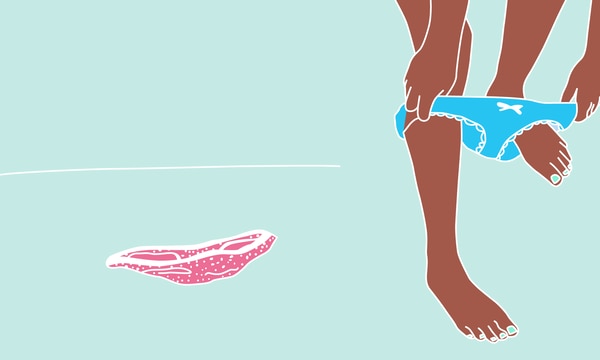
Let’s talk intimate fluids

We all know that feeling, when you go to the toilet and think, “WTF!?” (that’s What The Fluid?!) is in my pants, and what does it mean? Fear not, intimate fluids are completely normal and all part of the parcel of being a woman.
Getting to know your flow
But the great news is when you know what to expect and why it’s happening, you’ll be able to read those mysterious marks like the V-Zone (that’s a women’s whole intimate area – vagina, vulva and V-shaped front one can see) equivalent of tea leaves. Happy days.
This guide will help you spot spotting, decipher discharge, and – whether you’re seeing red, yellow, white, gray, or green – have you going with the flow.
Discharge
If you’re seeing discharge in your underwear, great news – it’s completely normal. Producing fluid like this is just one of the amazing ways your vagina rebalances and cleans itself. Nice work, vagina.
The colour varies depending on where you are in your cycle; from milky egg-white and cream to pale pink and yellowy green. It can be affected by hormonal changes like pregnancy and ovulation , can change depending on arousal (more on that later) or even from taking new vitamins, antibiotics or certain foods [1].
When to see a doctor
Don’t fret too much, discharge can be a really good way to check in with your body. If you’re experiencing itching, a cottage cheese like texture or unpleasant fishy odours, it could be a sign of an infection [2]. Book an appointment with your doctor if you’re not sure.

White, clear, creamy or even pale pink – your discharge changes throughout your cycle. Bright yellowy green – especially with an unpleasant smell – could be a sign of infection, so keep an eye out.
Spotting
If you have periods – even irregular ones, you’ll probably have experienced spotting . It’s what we call the bloody discharge that occurs throughout your cycle – often starting out pink at the beginning of your period, then turning a bright cherry red and then a rusty brown at the end [1]. Think of it like a pantone colour chart, in your pants. It could also be down to a switch in your birth control, or more hormonal changes, like pregnancy or menopause.
When to see a doctor
If you do see red throughout the month, it could be a sign of a health issue, like an infection so check in with your body and talk to your GP or gyno if you notice any changes.

From bright cherry red to rusty reddish brown, the bloody discharge in your pants is what we call spotting.
Sexual fluids
When you’re aroused, your vagina releases a clear watery discharge – this is created when the blood vessels in your vaginal passage dilate causing fluid to pass though [3]. This cervical fluid provides lubrication to prevent tearing or pain during sex, whether that’s penetrative or otherwise, partnered or with yourself.
Despite this, some women may experience light bleeding after penetrative intercourse, causing a pale pink discharge to appear.
For women going through the menopause (or at certain points in your menstrual cycle), you might find that your vagina is drier than normal. This is caused as your hormones change, producing less oestrogen and progesterone [4]. This doesn’t mean you can’t still have great sex - instead try a water-based lubricant or a vaginal moisturiser.
When to see a doctor
If you’re getting pain, or thicker, smellier discharge after sex this could be a sign of an infection like BV [2]. Bacterial Vaginosis is really common, and happens when the delicate pH balance of your vagina is upset, for example from sex, masturbation or not cleaning sex toys properly. It’s a simple solve with antibiotics, so keep an eye (and a nose) out for anything that doesn’t feel quite right.

White, clear and watery and even palest pink post-intercourse, it’s completely normal for sexual fluids to appear in your pants.
Pee
We’ve all been there. One minute you’re laughing, the next, things suddenly aren’t quite so funny. But hey, accidents happen. Light incontinence can occur at any age, but becomes more common after first childbirth, and as a result of hormonal changes through menopause [5]. Kegel exercises can help to strengthen your pelvic floor muscles (the muscles you squeeze when you stop yourself pee) [6], and liners can help to reduce odour and keep your pants from getting wet.
When to see a doctor
Frequent incontinence can be a sign of something more serious, so it’s important to book a doctor's appointment if you’re worried about any bladder weakness you’re experiencing.

Stress incontinence is more common than you’d think, and can occur at any age.
Sweat
Much like your armpits, your V-Zone area is packed with sweat glands and hair follicles so it’s natural for things to get warmer and let’s face it, wetter than the rest of you.
All that trapped heat means that your V-Zone is the perfect breeding ground for bacteria, but you can combat this by opting for cotton underwear instead of synthetics, avoiding tight clothing making sure to always wash or change your underwear post-exercise [7].
When to see a doctor
If you do notice any itching, a change in discharge and any other irritation, it might be from a yeast infection that thrives in warm conditions, like “sports vagina” or BV [8]. Don’t sweat it – these are easily treatable, chat to your GP if you’re worried.

Sweating from your V-Zone is perfectly normal, and makes sense when you think how many sweat glands and hair follicles are down there.
Checking in
So, intimate fluids are totally normal and nothing we should feel ashamed or embarrassed about. In fact, they’re your body’s way of keeping you in the know about what’s happening inside. But as always, it’s important to check in, speak up and discuss any worries with a doctor.

A liner for every intimate fluid
References
[1] https://www.healthline.com/health/vaginal-discharge-color-guide
[2] https://www.healthline.com/health/lots-of-discharge
[3] https://www.healthline.com/health/white-discharge-during-sex
[4] https://www.healthline.com/health/menopause/symptoms-signs#dryness-and-pain
[5] https://www.healthline.com/health/urinary-incontinence
[6] https://www.healthline.com/health/kegel-exercises#for-women
[7] https://www.healthline.com/health/womens-health/sweaty-vagina


